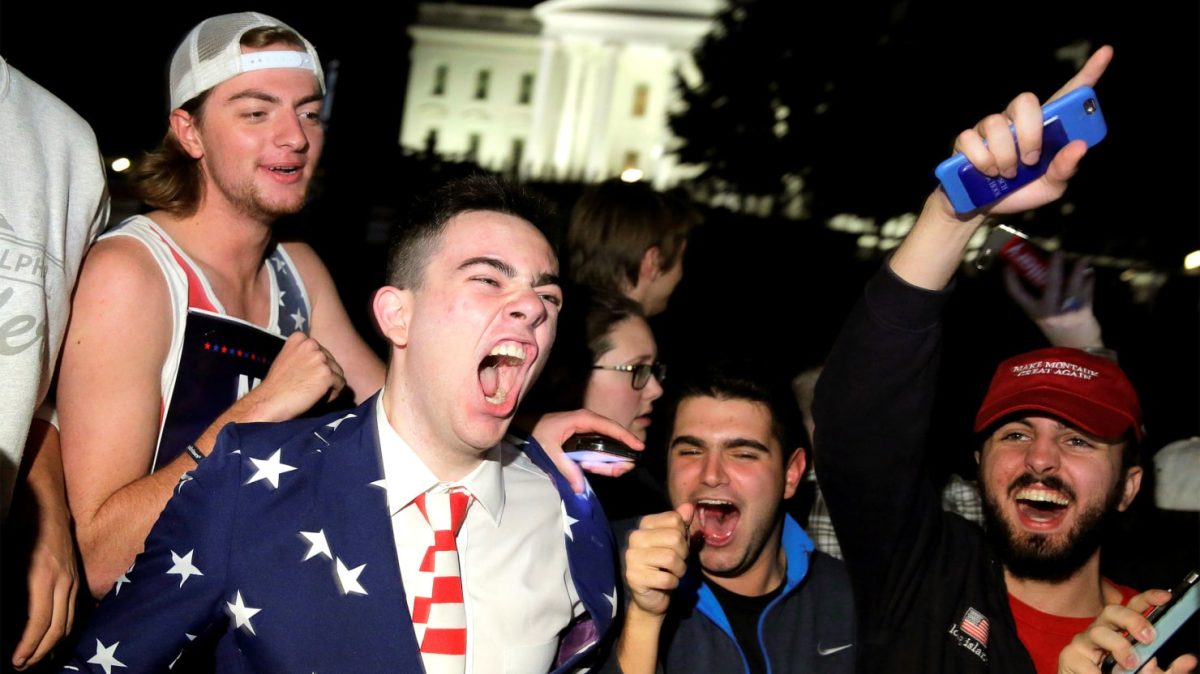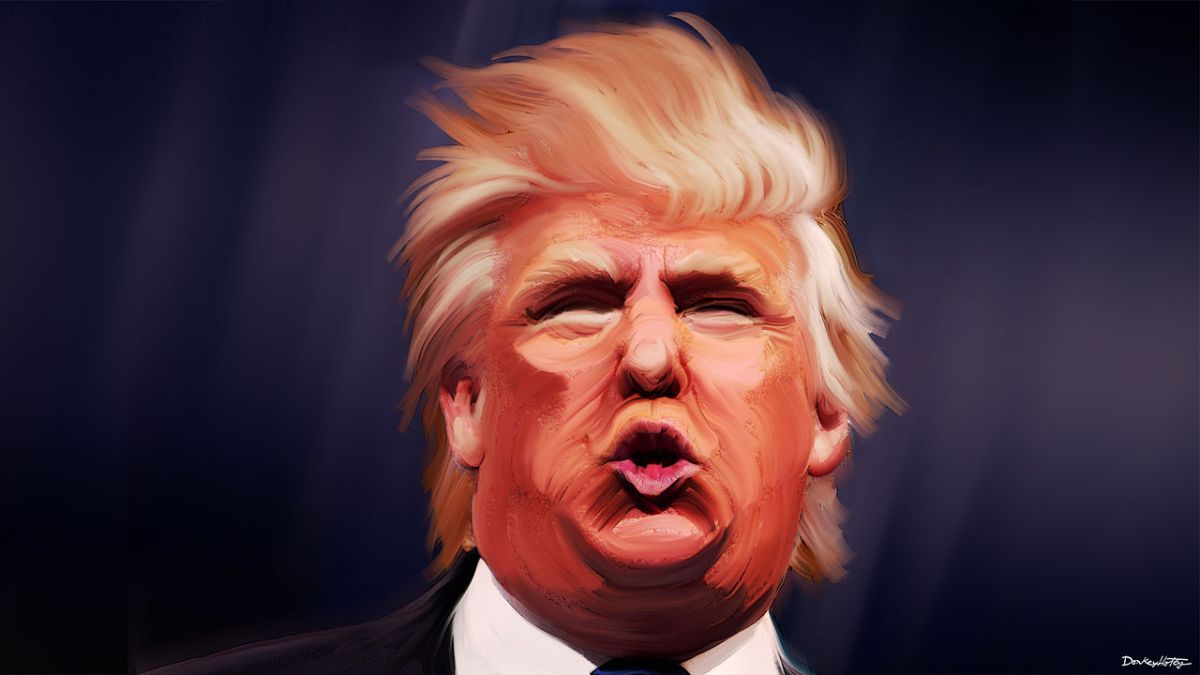1.0 Introduction
This rhetorical analysis will closely examine the underlying narratives in the political landscape leading up to, and since the 2016 American presidential elections within the US. As the ideological gap between progressives and conservatives steadily widens around the western world, we are seeing the emergence of identity-centric language used by each side to cultivate support. The consequence to this focus on identity politics, either intended or not, is a growing gap between the two larger groups; this increases the amount of rhetorical symbols to scrutinize as well. To properly analyze the discourse in a respectable scope, I will examine the methods and symbols used to convey this identity-centric narrative, through a wide selection of mediums and actions. Outside of two short introductory paragraphs, this analysis will cover four main areas of study. First, we’ll examine the modern duality of identity politics and how it’s being used by both sides. The idea of distinguishing ‘identity’ may differ whether it’s the left or right but the general purpose of the strategy remains the same. This section will also establish what narrative each side has built. Next, the analysis will branch off and mainly explore the written and visual symbols used by the American right wing to continue and exploit the identity/MAGA (Make America Great Again) narrative. There are many tools at the disposal of those within this public sphere, including mediums such as television, print, radio, apparel and social media. Lastly, this analysis will look at the agency of the public, specifically how demonstrating and voting itself became the most powerful symbol of all within this charged, political discourse.
In the next brief section, I will outline what the term ‘identity politics’ means for the context of this analysis.
1.1 Identity Politics
The Stanford Encyclopedia of Philosophy defines Identity politics as “a wide range of political activity and theorizing founded in the shared experiences of injustice of members of certain social groups.” (March 2016). Note this definition includes the idea of an ‘injustice’ being incurred by one side, this is important in the context of this analysis. As a precursor for understanding the broader narratives being told by the left and right, we have opposing, unilateral ideological arguments that appear to be mutually exclusive, using the same identity-centric strategies to convey a narrative, all while arguing and rallying from a position of marginalization.
2.0 Left Side of the Coin
For a long time, identity politics have been mostly attributed to left wing politics, particularly in the US. The term’s origins can be traced to the civil rights movements of Black and Latino activists during the 1960s and 1970s when political groups were formed to address social issues such as race and gender inequalities (Dade, 2011). The origins of identity politics are a half century old and it’s a strategy still heavily practised by the American left today. “All the social issues you may have heard of in the past several years — same-sex marriage, police shootings of unarmed black men, trans people in bathrooms, the fluidity of gender, discussions about rape culture, campus battles about safe spaces and trigger warnings — are typically the kinds of issues people mean when they refer to identity politics.” (Lopez, 2017). With progressives, and therefore the Democratic Party championing these issues, it’s no surprise the left has been associated with the term ‘identity politics’ so strongly. Collectively in 2017, the American progressive movement seems more focused on identity than ever before, as great strides are being made on various social issues typically regarding minorities. The emergence of LGBT acceptance and equality, Black awareness groups such as BLM (Black Lives Matter), women’s groups and the general climate of political correctness that dominate much of the discussion have all been focal points of the Democrats in recent years. Some progressives argue that Democrats have gone too far and have abandoned the economic and pragmatic governing platforms of the past for a unique brand of identity politics aptly named “identity liberalism”. Mark Lilla, a Professor at Columbia University and prominent progressive thinker, urged fellow progressives to abandon the influence of identity politics for a message of economic inclusiveness, claiming about identity politics, “It works for them. It doesn’t work for us. It’s that simple.” (Illing, 2017).
2.1 Right Side of the Coin
When we look at the US general election and many of the municipal and state level races that preceded it, Mark Lilla is correct in asserting that identity politics have been working for conservatives. White, rural Americans, feeling isolated by progressive identity politics and the narrative it was telling, began to themselves feel marginalized. In 2014, Ashley Jardina forecasted the environment in which a white identity could be realized and activated politically, “When whites perceive their group’s dominant status is threatened or their group is unfairly disadvantaged, however, their racial identity may become salient and politically relevant […] Recent social and political trends—including an erosion of whites’ majority status and the election of America’s first black president—have signaled a challenge to the absoluteness of whites’ dominance. Under these conditions, white identity may play a powerful role in political preferences.” (pg. 18. Jardina, 2014). This environment was eventually compounded by the Democrats relative silence during campaigns on the economic issues confronting the middle class. Conservatives and therefore the Republican Party began to craft a narrative for its voting base, based on these factors. This new narrative concentrated on white identity and economic class; a strategy that has paid off in spades.
Building an identity-centric narrative such as ‘white, middle-class American’ might be the end-goal of conservative identity politics but it’s a composite identity built up of many smaller ideas and represented with different, recognizable symbols. The slogan ‘Make America Great Again’, or ‘MAGA’ is the commercial and ideological culmination of these ideas and often acts as the ‘dog whistle’ to rally like-minded voters in the public sphere. Used to great effect by the Trump campaign, the phrase prompts white, middle class Americans to recall a time in history when the country’s institutions and economy were almost exclusively controlled by white Americans. Kelly Baker, recognizing the similarities between Trump’s campaign slogan and the Ku Klux Klan’s campaign slogans of the 1920s writes, “Trump’s “Make America great again” language is just like the rhetoric of the (Ku Klux) Klan, with their emphasis on virulent patriotism and restrictive immigration.” (2016).
As with most brands of identity politics, it’s an absolute appeal to ethos and pathos.
3.0 Written Symbolism
An effective method to communicate a centralized message to people who are spread over vast distances is through print, whether it be newsprint like magazines or through digitalized articles online. American conservatives are among the world’s most savvy producers of loaded, political news content. Conservative outlets such as Breitbart, Info Wars, Drudge Report and Fox, among many others, contribute hundreds of articles every day to the public sphere for its audience to digest. To overcompensate for a national media landscape that is typically perceived by conservatives to have a strong liberal bias, these right wing outlets are brash, sensational and unapologetic in their reporting. They often lead their audiences away from pressing issues and towards headlines that support the MAGA narrative being pushed by Republican leadership. Many of these articles marginalize other groups, building upon their own self-serving narratives and ethos. Some recent headlines from Breitbart include “Gabby Giffords: The Gun Control Movement’s Human Shield” and “Data: Young Muslims In The West Are A Ticking Time Bomb, Increasingly Sympathising With Radicals, Terror” (Media Matters, 2016). In these two particular examples, we see headlines that marginalize opposing groups or ideologies and build upon the greater conservative narrative of MAGA, without explicably saying ‘Make America Great Again’ or make America white again.
3.1 The Brown Guy Did It
To look more closely at an example which supports this MAGA narrative in print, Breitbart News published an article on October 17 of 2017 titled, “ICE Detainer Issued for Suspected Wine Country Arsonist in Sonoma Jail” (Street, 2017). The article claims that a homeless man, Jesus Fabian Gonzalez, who was in the country illegally, had started the wildfires in an affluent region of California which killed dozens and displaced hundreds of people. “Mr. Gonzalez, who is homeless and reportedly known by law enforcement to have been living under a nearby bridge, claimed he was cold and had lit the fire to stay warm. But it was a balmy 78 degrees when he and the plume of smoke were first observed.” (Street, 2017). However, the facts were distorted by Breitbart to support a MAGA narrative, as their claim was roundly debunked by officials and other news outlets. Niraj Chokshi of the New York Times, responded to the false allegations made by Breitbart just days later, “The dispute stems from the arrest on Sunday of Mr. Gonzalez, who had started a fire in the local park where he often sleeps, [Sherriff] Mr. Giordano said. The fire, which Mr. Gonzalez said he started to keep warm, threatened no structures and was quickly put out, the sheriff said. That arrest was reported locally, and rumors began to fly. The conservative media outlet Breitbart reported on Tuesday that Mr. Gonzalez was arrested “on suspicion of arson in Wine Country fires that have killed at least 40 residents.” That same day, Sheriff Giordano felt compelled to publicly deny the connection, saying there was no indication Mr. Gonzalez was involved with the deadly fires.” (2017). Plainly, Breitbart looked to capitalize on the anxieties of its audience by falsely attributing the deaths and suffering of upper-middle class Americans to a homeless immigrant. With numerous examples just like this published on a weekly basis by a multitude of conservative outlets, the MAGA narrative strengthens among its base.
3.2 Fake News & Echo Chambers
In a more moderate political climate, one might consider multiple news sources when formulating opinions on any given topic. The identity politics being played by both progressives and conservatives though further separates the ideological divide and builds distrust. This ideological divide and distrust carries over to the choice of media one consumes and helps create the dangerous environments known as ‘echo chambers’. These public hemispheres (within the larger public sphere) typically happen within the realm of social media and they effectively limit people’s interactions. Generally, these environments surround users with like-minded individuals and content, so the criticism and challenging of self-held ideas is rare. The most famous example of this echo chamber today might be found in the American president’s use of Twitter and his love for morning news program, Fox & Friends. Narratives and ideas that appear on the program also shortly after, appear in the president’s Twitter feed. This is a highly-publicized and classic example of an echo chamber. (Bauder, 2017). The problem of insulated media intake is not partisan though, it exists all over the spectrum, it’s also the way our social media feeds are designed in 2017 (Hosanagar, 2016). That being said, there is a special nuance that finds itself associated with the right wing and the type of information they end up consuming. The Columbia Journalism Review writes, “While concerns about political and media polarization online are longstanding, our study suggests that polarization was asymmetric. Pro-Clinton audiences were highly attentive to traditional media outlets, which continued to be the most prominent outlets across the public sphere, alongside more left-oriented online sites. But pro-Trump audiences paid the majority of their attention to polarized outlets that have developed recently, many of them only since the 2008 election season.” (2017). These relatively young news outlets are typically referred to as ‘alternative news sites’ because they report news (or narratives) that aren’t reported by traditional and moderate news outlets.
Out of this rhetorical situation comes the term ‘fake news’. It is a term used by conservatives and progressives when explaining each other’s news sources because so often, the narratives and facts being reported are so vastly different. These narratives differ from one another ideologically or factually, and typically are in direct conflict with one another. The term ‘fake news’, coined by then candidate Trump, has resonated with so many on all sides because it describes a larger narrative at play in this political landscape: ‘I’m right, you’re wrong’ or more accurately, ‘my narrative is right, yours isn’t’.
3.3 Logged On
As communication evolves, social media platforms have emerged as the most dynamic space for public and political discourse. As mentioned in the prior section, the medium has become so prolific that the US president uses his Twitter account to perpetuate narratives. “Unlike traditional media, social media improves reach, frequency, permanence and immediacy. Social media allows the interactive communication between people without spatial limits or time constraints and offer the opportunity to transfer the content of any messages under any form (vocal, visual, written) to anyone on the planet. Social media has become an amplifier of ideas, a creator of meaning and a generator of conflicts as well.” (Rickli, Kaspersen, 2016). It’s important to note that social media not only hosts a large portion of this public sphere, but it facilitates the creation of new ideas and evolves the broader narratives.
4.0 Visual Symbolism
From ball caps to smiling green frogs, there has been no shortage of visual symbols used by the American right to engage its base and perpetuate its narrative in recent years. Visual symbols however, are not limited to clothing, television programs and illustrations, as many actions can constitute as communicating a message. Though the modes of delivery can vary greatly when examining visual symbolism, its purpose remains the same as written symbolism, which is to convey a narrative within the public sphere.
4.1 Monkey See, Monkey Do
When a message becomes so energized that it’s in full realization, a whole narrative can be encapsulated in just the right symbol. Perhaps the most well-known symbol of the entire MAGA narrative, a symbol that represented the political divide better than anything like it, was the red, ‘Make America Great Again’ hat made infamous by now president, Donald Trump. “It was a little more than a month after he announced his candidacy that Trump first donned the hat in public at a campaign event. When he made a much-publicized trip to Laredo, Texas, in July 2015 to visit the US-Mexico border, the hot weather necessitated a more casual look than his usual suit and tie.” (Spodak, 2017). The hat became the unifying symbol of what the greater narrative told and it was remarkably accessible for anyone to use; to wear the hat was to own the message that came with it. It was casual and represented the crucial narratives about white identity and economic prosperity that Trump sold over the course of his campaign. Trump’s former campaign manager Corey Lewandowski, told CNN in 2017, “People who weren’t involved in politics, that didn’t have a political background, wanted to show their support for something different and their way to do that was to buy hats.” (Spodak, 2017).
The hats have been wildly successful for Trump and he continues to produce and sell them to his supporters by the thousands. As the defining symbol for the movement though, the hat has been satirised by comedians and burned by activists for its charged symbolism. In February of 2016, comedian John Oliver launched a widely publicised campaign on his television show, poking fun at the narrative behind Trump and the MAGA hat. The campaign, ‘Make Donald Drumpf Again’, sold similar red hats on a website setup specifically for the cause. Oliver’s purpose was to pacify the powerful symbolism behind Trumpism and distort the message that came with it. He argues the name Trump itself has powerful symbolism in it, so the public should refer to him by his original, European family name, Drumpf. “While Trump is the sound produced when a mouthy servant is slapped across the face with a wad of thousand dollar bills […] Drumpf resembles the sound produced when a morbidly obese pigeon flies into the window of a foreclosed Old Navy” (Brait, 2016).
4.2 Talking Heads & Fox
Despite the prevalence of social media in recent years, much of the political discourse in the United States is still fueled by the images on television screens. Network news channels in particular are major catalysts for these discussions, most having inherent political leanings. Perhaps the most prolific network news channel in terms of narrative-pushing, is Fox News. What Breitbart and Info Wars are to the written symbols of the MAGA narrative, Fox is their visual counterpart. Fox News is constantly selling a conservative agenda, often at the expense of their journalistic integrity. Tim Dickinson, writing for Rolling Stone magazine in 2011, “[It] plays a leading role in defining Republican talking points and advancing the agenda of the far right. Fox News tilted the electoral balance to George W. Bush in 2000, prematurely declaring him president in a move that prompted every other network to follow suit. It helped create the Tea Party, transforming it from the butt of late-night jokes into a nationwide insurgency capable of electing U.S. senators.” (2011). Network news outlets such as Fox, play a vital role in carrying the narratives forged in the public sphere in America. Fox’s strength is its accessibility because of its conventionality, Fox News alone makes its way into 100 million American households every day.
5.0 Pitchforks at the Voting Booth
The physical assembly of activists and organizers within a political narrative is a visual symbol applied through agency. When people attend a rally or protest, they are collectively forming a symbol to further a narrative. What makes this special in terms of rhetorical communication, the agent herself becomes the symbol of the narrative, by her physical action. When Confederate monuments were being removed in the spring and summer of 2017, ‘alt-right’ rallies were held in multiple American cities to express anger over the issue. The most notable example came in August of 2017 in Charlottesville, Virginia, “white supremacists converged on Charlottesville, Va. to protest the pending removal of a statue of Confederate Gen. Robert E. Lee. Their stated goal: to “take America back” — and to begin doing so by saving Lee’s monument, which has become a lightning rod since the local city council voted to remove it earlier this year.” (Dwyer, 2017). Not only were the opposing activists a symbol supporting a narrative, but the monument itself became an important symbol in the discourse.
The most definitive exercise of agency, and the culmination of the many symbols of this political discourse, is the act of voting. This is where we get a sense of how successful the progressive and conservative narratives were during the general elections.



